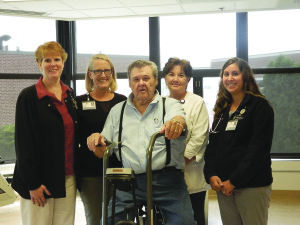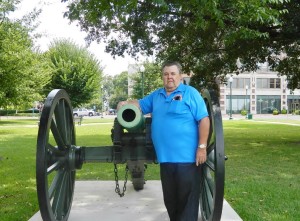The Gettysburg Hospital’s Cardiac Rehabilitation is for Veterans and Civilians — A New Lifestyle for the Rest of Your Life
experience concerning issues with my heart. I wrote of my experience with the staff of the two hospitals—Gettysburg and York—where I was treated for my heart condition. I would now like to follow up on my experience with learning a new way of life at The Gettysburg Hospital’s Cardiac Rehabilitation Unit, and the wonderful, professional staff who operate it.
I was home recuperating from a recent surgery I underwent to have a stent inserted due to a 99 percent blockage of the right artery of my heart, when I received a phone call from Wendy, who said she was from Gettysburg Hospital’s Cardiac Rehabilitation Unit. She asked if I knew anything about the Unit, and I told her I did not. She proceeded to explain what it was all about and how it would be beneficial for me to enroll in the program. She told me that she would get back to me in a few days, and that would give me time to think about it. She discussed the rule was to wait at least four weeks after surgery before starting the program. Well, I knew if I decided not to accept some help and continue on the path I was on, I would be—as much as I didn’t want to be—back in the same condition as when my heart problems began. I gave it a lot of thought and decided that when she called me back, I would go for it.
True to her word, Wendy called me back and I told her my decision; she welcomed me aboard to start the program. She said I would be enrolled for ten to twelve weeks and we then discussed what times and days would suit me best. I told her I would leave that up to her, as I could work my schedule around whatever she decided. Wendy set my time for Mondays, Wednesdays, and Fridays at 8:00 a.m.
I reported to my scheduled appointment and was greeted by Susie; we went through the preliminaries of being signed in and being asked questions about my medication and general health. She took measurement of my waist, my height, and my weight; she then showed me how to hook up electrodes to a small machine that monitored my heart rate and pulse and other things during the entire time I was there. I was shown how to hook up my monitor and fill out a check-in sheet and to weigh myself each morning when I arrive at class. The blood sugar test and blood pressure test are taken before any exercises. If the blood sugar is low, they give you some nourishment to bring it up before exercise. They are very alert to your vital signs, and if they are not right or you are not feeling well, they will call your doctor and most likely you will not be exercising that day. I only had to call off one day and that was because I had overdone it the previous day by working sixteen hours straight.
The first exercise was a six-minute walk, where I was evaluated for blood oxygen, heart rate, and pulse, and to see how many laps I could do in six minutes on a previously marked-off course. My blood pressure and blood sugar were regularly checked, because I not only have a heart condition but I also have diabetes. This monitoring system was routine each and every time I attended class, and I never met a more professional or caring team of nurses anywhere.
The class I was in consisted of two women and three men, including myself. I started out as everyone else did at three minutes on each machine, with three minutes of cool down time (walking and wiping down the machine you had just used). You were to use six machines of your choice, but to alternate between arm exercise and leg exercise machines. You are then asked to rate each session on a scale from very easy to very hard; depending on the rating you give, adjustments are made to the machines as far as difficulty and when you advance in time. We were asked to have an exercise routine at home on the days we are not in class. I choose my home exercise routine as a ten-minute walk twice a day and a bicycle ride once a day.
I have been walking, but I need a chain for the bicycle my granddaughter donated to me. When I get the bike in riding condition, I will go to the parking lot of the school that is near me and ride each day for a half hour or so.
If it sounds like I enjoy it, that is because I do, and I never thought I would say that about exercising. I have enjoyed not only the exercising part of the class but also the education part, because all of the professionals—Andi, Laura, Carol, Susie, Wendy and Ben—are all so very knowledgeable about the subjects they deal with on a daily basis. I thank each and every one of these wonderful people for keeping me on point and focused so that I now have a chance to survive my health issues. I have moved to three-and-one-half minutes of exercise and two-and-one-half minutes of cool down; you move up one-half minute exercise and down one-half minute cool down until you reach six minutes exercising and no minutes cool down.
The rehabilitation program was a lot of hard work, but a lot of fun as well. When I graduated the program, there were only two of us in the class: Ron and me. Ron has a few more classes to take before he graduates. What a great team they are at the Cardiac Rehabilitation Unit.
I would recommend the Cardiac Rehabilitation Unit at Gettysburg Hospital, and their staff, to anyone with a cardiac problem who would like to have a longer, enjoyable life. I feel so enriched by doing this and thank the staff there very much. They even played Pomp and Circumstance for my graduation.
God Bless the United States of America, God Bless the American Veteran, and God Bless You.

Jim Houck, Jr. (center) is shown on the AireDyne with (from left) Wendy, Carol, Andi, and Laura, a few of the wonderful and dedicated staff at Gettysburg Hospital’s Cardiac Rehabilitation.

 Thank you one and all for taking the time to read my column, which is dedicated to the Veterans in our local neighborhood communities and across this great land of ours. I am aware that quite a few of you know that I have been in the hospital, and I thank all of you for your prayers, as I greatly believe that the good Lord answered them and that is why I am able to write this today.
Thank you one and all for taking the time to read my column, which is dedicated to the Veterans in our local neighborhood communities and across this great land of ours. I am aware that quite a few of you know that I have been in the hospital, and I thank all of you for your prayers, as I greatly believe that the good Lord answered them and that is why I am able to write this today. 